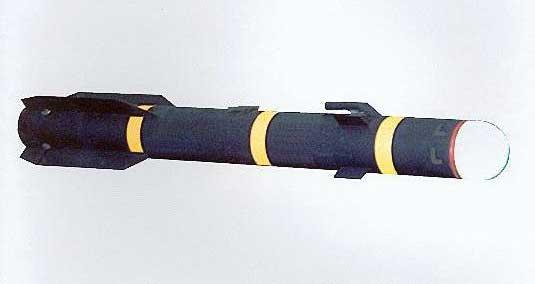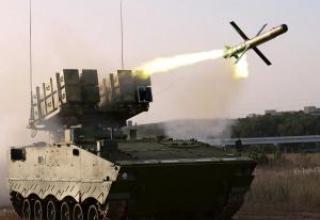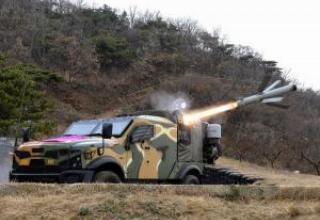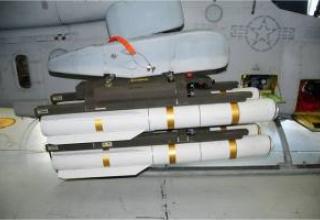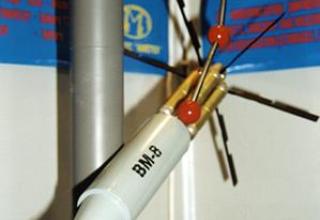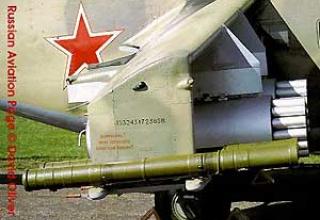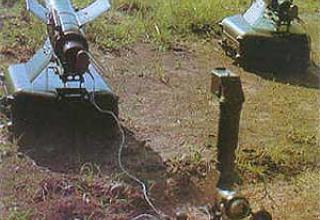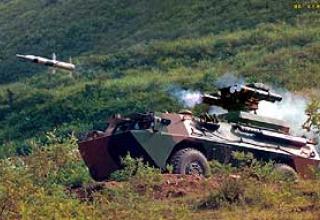The AGM-114L Hellfire-Longbow anti-tank missile system with an active homing radar head is designed to destroy enemy tank formations and other small targets at any time of the day, in poor visibility and in difficult weather conditions.
The complex is developed by Rockwell International and Lockheed Martin companies on the basis of AGM-114K Hellfire-2 missile within the framework of AAWWS (Airbone Adverse Weather Weapon System) program for AH-64D Apache and RAH-66 Comanche attack helicopters. The efficiency of the Apache helicopter, equipped with a complex Longbow, has increased significantly due to the possibility of using missiles in bad weather, the possibility of multiple launch on a cluster of armored vehicles, as well as a significant reduction in the time of finding the helicopter under enemy fire in pointing missiles.
The first firing test PTRK AGM-114L Hellfire-Longbow was conducted in June 1994. The complex was adopted for service by the U.S. Army in 1998. Estimated purchase volume - 12905 pieces. Longbow Limited Liability Co (LBL) was established to produce the complex under the agreement between Lockheed Martin and Northrop Grumman.
According to unconfirmed data, the complex was used by NATO forces during the aggression against Yugoslavia in 1999.
Composition:
Like the previous versions of Hellfire AGM-114L missile is made in a modular design and consists of five compartments: the homing head (CNS), combat unit (BC), control system, engine and controls. The control system consists of a compressed gas cylinder, thermal battery, autopilot and inertial control system with a three-stage gyroscope. Solid fuel engine is Thiokol TX-657 (US Navy designation - T773-3, US Army designation - M120E1), equipped with a low smoke charge. The combat unit is tandem cumulative.
Due to the modular design of the missile provides a high degree of interchangeability of units and assemblies of the entire model range of AGM-114 missiles.
Marconi Electronic Systems has developed an active millimeter-range GSN for AGM-114L PTUR. CNS is characterized by high noise immunity, resolution and accuracy due to a narrow radiation pattern of the antenna. The range of the SOS is from 12 to 16 km. Transmitting device CNS, placed behind the antenna, is made on chips based on gallium arsenide. The operating frequency of the CNS (94 GHz) is selected to ensure reliable operation in rain, fog and the highest resolution. Marconi Electronic Systems' Marconi COS system, called Brimstone, is adopted in the UK.
Targets are searched for by means of the TADS (Target Acquisition Disignation Sight) or AN/APG-78 (FCR - Fire Control Radar) Sighting System, the data from which is transferred to the AGM-114L missile CNS.
The sighting system has an infrared tracking system with 30x magnification AN/UAS-12C, which provides a thermal image of the target day and night, daytime television camera and DVO camera for full color magnification of the target, both in darkness and in sunlight.
The radar AN/APG-78 has stealth, which increases the survivability of the helicopter on the battlefield and in combination with on-board equipment provides:
- automatic detection of moving and stationary targets;
- recognition and determination of the importance of the observed target by five classes of ground and air targets;
- tracking of detected targets whose coordinates are transmitted to the AGM-114L missile.
The missile can capture a target either before launch or after launch, depending on whether the target is in the area of the missile's CLO. In the latter case, the missile's movement is controlled by an inertial control system on the initial flight section. Guidance AGM-114L missile is possible with the transfer of external target designation through data transmission from other helicopters with a complex Longbow, with the helicopters can be located at a distance of more than 700 meters from each other.
Hellfire-Longbow complex includes a new two- or four-position launcher M299. The M299 is designed for standard 356 mm NATO suspension units and features the MIL-STD-1760 digital multiplexer interface. The weight of the empty M299 PU in two positions is 43.6 kg, in four positions it is 66 kg. Weight of equipped PU is 141 and 260 kg, respectively. M299 can be used to launch all previous versions of Hellfire missiles, starting from AGM-114A.
The program HOMS (Hellfire Optimized Missile System) of further modernization of Hellfire PTUR, offered by the developer company, assumes performance of works in the following directions:
- To equip the AGM-114 missile with a cumulative warhead with two leading charges, which are triggered in series before detonating the main charge of the BC, which allows to overcome the multilayer dynamic armor of modern and advanced tanks.
- The development of a pulsating marching engine, the use of which will increase the range of the missile by 50%.
- Reduction of the frontal resistance and launch weight of the missile to 36.3 kg by optimizing the missile design and using modern materials.
- equipping the missile with thrust vector control systems and a boundary layer to improve the maneuverability of AGM-114.
- For AGM-114 missile Rockwell International offers infrared CNS with mosaic receiver on cadmium telluride (Cd-Te) in focal plane containing 128x128 sensitive elements. The missile with this Cd-Te can be used both against tanks and against enemy helicopters.
Characteristics:
| Range of fire, m | 0.5 - 9000 |
| Rocket velocity, M. | 1.1 |
| The weight of the rocket, kg | 45.7 |
| Body diameter, mm | 178 |
| Length, mm | 1630 |
| Swing of stabilizers, mm | 326 |
Testing:
The first flight test of the XMG-M52C "Lance" rocket with extended range was conducted at White Sands Range on March 6, 1969. The first series of missiles entered the army for military trials in April 1971. The first launch took place in August 1972, and in March 1972 the military trials were fully completed.
In May 1972, the missile system "Lance" was officially recognized as a protocol model of military equipment and was classified as a class "Standard A". However, only a Lance missile with a nuclear warhead was included in this class, as Congress had not yet approved the development of a cluster bomb head unit, which the command of the ground forces considered necessary to have in service.
Immediately after the approval of the missile, the delivery of the Lance missile system to NATO partners and Israel began. Six divisions were formed in Europe. Two of them were in Germany, which could not but bother the USSR Armed Forces group "Center": the flight time of the Lance missile is only about 200 seconds, so there was no way to quickly detect and shoot down the missile. Missiles equipped with non-nuclear head units were delivered to Israel.
There are reports that the Lance missile system was used by U.S. forces during the war in Afghanistan in the late 70's and early 80's.
In the mid-80s, the Lance missile system was withdrawn from service due to the nuclear arms reduction treaty between the USSR and the United States. Currently, the Lance missile is used as a target for anti-missile testing. There is evidence that it is used in the development of the US national missile defense program.

